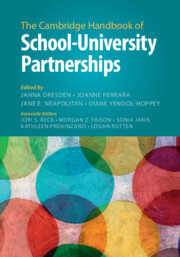Book contents
- The Cambridge Handbook of School–University Partnerships
- The Cambridge Handbook of School–University Partnerships
- Copyright page
- Contents
- Figures
- Tables
- Contributors
- Foreword
- Preface
- Acknowledgments
- Part I The History and Conceptual Foundations of School–University Partnerships
- Part II Teachers and Learning to Teach in School–University Partnerships
- Part III Equity and Student Learning in School–University Partnerships
- Introduction to Part III: Equity and Student Learning in School–University Partnerships
- 18 Examining the Link Between School–University Partnerships and Student Learning Outcomes
- 19 Educational Equity and Student Learning in School–University Partnerships
- 20 Beyond Educator Preparation
- 21 Equity and Anti-racism at the Center of the Work
- 22 Commentary: Equity and Social Justice in the Context of School–University Partnerships
- 23 Commentary: Synergy and Sankofa
- 24 Commentary: Situating School–University Partnership Research for Social Justice
- Part IV Leadership in School–University Partnerships
- Part V Community Schools as School–University Partnerships
- Part VI Inquiry and Innovation in School–University Partnerships
- Part VII Funding, Policy, and the Politics of School–University Partnerships
- Part VIII Looking at School–University Partnerships across Geographic and Cultural Borders
- Index
- References
18 - Examining the Link Between School–University Partnerships and Student Learning Outcomes
from Part III - Equity and Student Learning in School–University Partnerships
Published online by Cambridge University Press: 05 November 2025
- The Cambridge Handbook of School–University Partnerships
- The Cambridge Handbook of School–University Partnerships
- Copyright page
- Contents
- Figures
- Tables
- Contributors
- Foreword
- Preface
- Acknowledgments
- Part I The History and Conceptual Foundations of School–University Partnerships
- Part II Teachers and Learning to Teach in School–University Partnerships
- Part III Equity and Student Learning in School–University Partnerships
- Introduction to Part III: Equity and Student Learning in School–University Partnerships
- 18 Examining the Link Between School–University Partnerships and Student Learning Outcomes
- 19 Educational Equity and Student Learning in School–University Partnerships
- 20 Beyond Educator Preparation
- 21 Equity and Anti-racism at the Center of the Work
- 22 Commentary: Equity and Social Justice in the Context of School–University Partnerships
- 23 Commentary: Synergy and Sankofa
- 24 Commentary: Situating School–University Partnership Research for Social Justice
- Part IV Leadership in School–University Partnerships
- Part V Community Schools as School–University Partnerships
- Part VI Inquiry and Innovation in School–University Partnerships
- Part VII Funding, Policy, and the Politics of School–University Partnerships
- Part VIII Looking at School–University Partnerships across Geographic and Cultural Borders
- Index
- References
Summary
This chapter includes a systematic review of 111 peer-reviewed articles that were identified through ERIC via EBSCO Host with keywords related to student learning, student achievement, school–university partnerships, and professional development schools. Despite the keyword indicators focused on student outcomes, only twenty articles actually included student learning data, while 36 included data on teachers, teacher candidates, or administrators related to partnerships hoping to improve learning, and 65 articles were descriptive and included no data sources at all. We use a case from our own partnership work to provide a potential framework for future research in School–University partnerships and elaborate on implications for consideration for scholars hoping to link partnerships and their influence on student learning outcomes.
Keywords
Information
- Type
- Chapter
- Information
- The Cambridge Handbook of School–University Partnerships , pp. 287 - 307Publisher: Cambridge University PressPrint publication year: 2025
References
Accessibility standard: WCAG 2.1 AA
Why this information is here
This section outlines the accessibility features of this content - including support for screen readers, full keyboard navigation and high-contrast display options. This may not be relevant for you.Accessibility Information
Content Navigation
Allows you to navigate directly to chapters, sections, or non‐text items through a linked table of contents, reducing the need for extensive scrolling.
Provides an interactive index, letting you go straight to where a term or subject appears in the text without manual searching.
Reading Order & Textual Equivalents
You will encounter all content (including footnotes, captions, etc.) in a clear, sequential flow, making it easier to follow with assistive tools like screen readers.
Visual Accessibility
You will still understand key ideas or prompts without relying solely on colour, which is especially helpful if you have colour vision deficiencies.
Structural and Technical Features
You gain clarity from ARIA (Accessible Rich Internet Applications) roles and attributes, as they help assistive technologies interpret how each part of the content functions.
